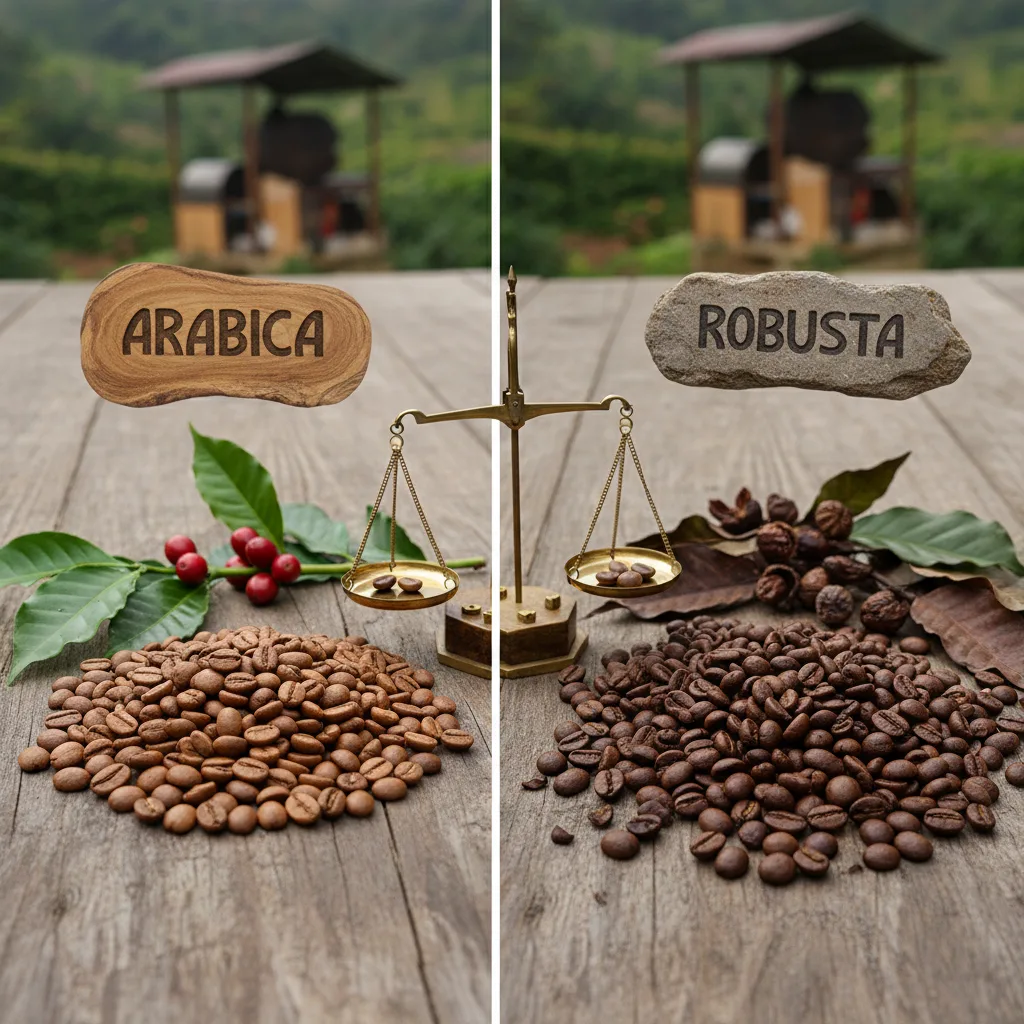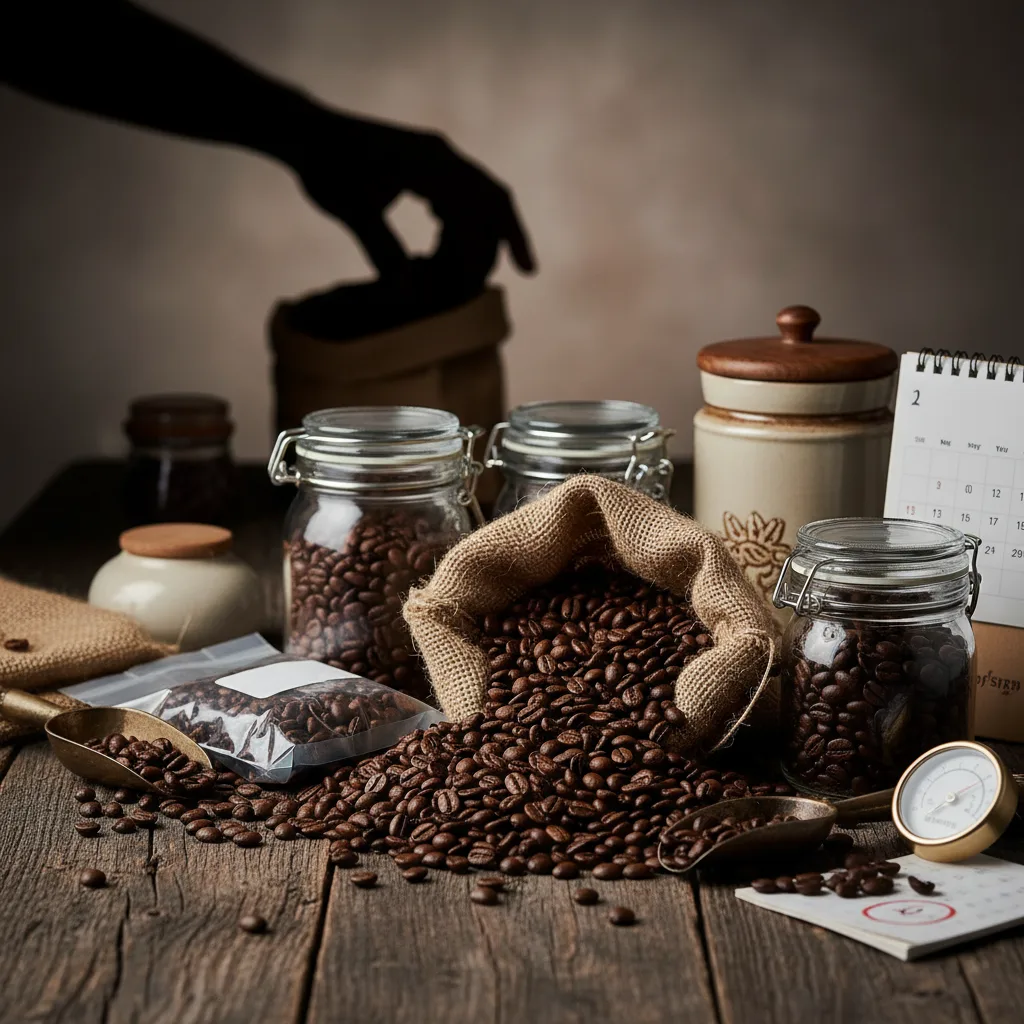Table of Contents
Welcome to Espresso Insider, where we dive deep into the world of coffee to help you brew the perfect cup. If you’ve ever sipped a truly amazing coffee and wondered what made it so special, chances are you were enjoying the delicate nuances of Arabica coffee beans. Often hailed as the king of coffee, Arabica is celebrated for its complex flavors and aromatic qualities. But what exactly are these beans, and why do they stand out so much from other varieties?
Join me as we explore the fascinating journey of Arabica, from its ancient origins to the intricate dance of flavors it brings to your mug. We’ll uncover the secrets behind its distinct taste, compare it to its robust cousin, Robusta, and learn how to get the most out of every single bean.

Key Takeaways
- Arabica coffee beans are the most popular and widely cultivated coffee species globally, known for their superior flavor and aroma.
- They differ significantly from Robusta beans, offering a milder taste, lower caffeine content, and a more complex flavor profile with notes of fruit, chocolate, and floral hints.
- Factors like altitude, climate, and processing methods heavily influence Arabica’s unique taste characteristics, creating diverse regional flavors.
- Proper storage and understanding different brew methods are crucial to unlocking the full potential and rich flavors of your Arabica coffee beans.
- While often considered “better,” the choice between 100% Arabica and an Arabica/Robusta blend depends on personal preference for taste, caffeine, and desired brewing outcome, especially for espresso.
What Are Arabica Coffee Beans?
When we talk about coffee, we’re usually talking about Arabica Coffee Beans. They make up around 60% of global production and are valued for their rich aroma and smooth, complex flavor. These beans come from the delicate Coffea arabica plant, which grows best in specific conditions.
Arabica beans are not just a name; they represent consistent quality and a delightful coffee experience. We hear about them often, and knowing what sets them apart helps us appreciate every sip even more.
Arabica vs Robusta in Simple Terms
To truly understand Arabica, it helps to compare it to its main rival: Robusta. Think of Arabica as the sophisticated, high-maintenance artist, and Robusta as the hardy, no-nonsense worker.

Arabica Coffee Beans offer a sweet, smooth taste with chocolate, nutty, and fruity notes, plus bright acidity. The plants thrive in high altitudes and moderate climates but are vulnerable to pests, making them harder and more expensive to grow—yet the quality shows in every cup.
Robusta coffee beans are easier to grow because the Coffea canephora plant resists disease and thrives in hot, low-altitude climates. The beans have a strong, bitter taste and contain nearly twice the caffeine of Arabica, producing a thicker crema. They’re often used in instant coffee and espresso blends to add body and lower costs.
Origins and Growing Regions
The story of Arabica coffee beans begins in Ethiopia’s highlands, where legend says a herder named Kaldi noticed his goats becoming energetic after eating certain berries. From there, coffee reached Yemen, where it was first cultivated and consumed, before spreading across the Middle East, Europe, and eventually the Americas.
Today, Arabica coffee beans are grown across the equatorial “Bean Belt,” which spans Latin America, Africa, and Asia. Each region gives the beans unique qualities shaped by its soil, climate, and processing methods.
- Latin America (e.g., Colombia, Brazil, Costa Rica, Guatemala) produces most Arabica coffee beans. Colombian beans are balanced with bright acidity and citrus-nut notes, while Brazilian beans are heavier, chocolatey, and perfect for espresso.
- Africa (e.g., Ethiopia, Kenya, Rwanda) produces Arabica coffee beans with vibrant flavors. Ethiopian Yirgacheffe is floral and bright, while Kenyan beans are full-bodied with wine-like acidity and fruity notes.
- Asia (e.g., Indonesia, Vietnam – though Vietnam is mostly Robusta, some Arabica is grown, especially in Sumatra): Specialty Arabica coffee beans from Sumatra have earthy, woody flavors, low acidity, and a full body.
These diverse origins make Arabica coffee beans full of unique flavors. Single-origin beans often indicate their region or farm, hinting at their taste. Arabica coffee beans are the foundation of quality coffee, prized for their nuanced flavors and delicate nature.
Flavor Profile of Arabica Coffee
The magic of Arabica coffee beans is in their diverse flavors—sweet, fruity, floral, nutty, or spicy. Unlike Robusta’s strong taste, Arabica’s complexity attracts coffee enthusiasts and Q Graders who train for years to discern its subtle notes.
When we talk about the flavor profile, we’re not just guessing; we’re using a common language. This language helps us describe what we taste and smell in our cup.
Typical Tasting Notes
Tasting Arabica coffee beans reveals more than just “coffee” flavors. Their inherent aromatic compounds, developed during growth, processing, and roasting, evoke familiar foods and scents.
Here are some of the most common tasting notes you might find in Arabica coffee beans:
- Chocolatey/Cocoa: Common in Brazilian and Colombian beans, with flavors like milk or dark chocolate, or unsweetened cocoa, offering a comforting base note.
- Nutty: Almond, hazelnut, pecan, or walnut notes often accompany chocolatey flavors, adding a smooth, rounded mouthfeel.
- Caramel/Toffee: Sweet, buttery, and rich notes from sugar caramelization during roasting add delightful sweetness to the cup.
- Fruity: This can range widely depending on the origin.
- Citrus: Lemon, orange, grapefruit. Common in Central American and some African coffees, indicating bright acidity.
- Berry: Blueberry, raspberry, and strawberry notes, often in Ethiopian coffees, add a sweet, sometimes jam-like quality.
- Stone Fruit: Peach, apricot, plum. These add a juicy, sweet depth.
- Floral: Jasmine, rose, bergamot. Delicate and aromatic, these notes are a hallmark of high-quality African Arabicas, particularly from Ethiopia.
- Spicy: Cinnamon, clove, cardamom. Less common but can add an interesting warmth and complexity.
- Herbal/Grassy: Sometimes found in lighter roasts or certain origins like Sumatra, adding an earthy, fresh quality.
- Wine-like: A complex note found in some African coffees (like Kenya), combining fruitiness with a pleasant acidity and sometimes a slight fermented character.
These flavors depend on the Arabica varietal, soil, altitude, climate, and post-harvest processing—a symphony of natural influences.
“Arabica’s complexity is its crown jewel. Each bean holds a story of its origin, a whisper of the soil, sun, and rain it experienced.”
How Altitude and Origin Change the Cup
The environment where Arabica coffee beans grow greatly affects their flavor. Two main factors are altitude and origin.
Altitude: Arabica plants thrive at 2,000–6,000 feet above sea level.
- Slower Maturation: Cooler, high-altitude conditions slow cherry development, letting beans absorb more nutrients and develop a denser structure.
- Concentrated Sugars: Slower maturation increases sugars and complex acids, which caramelize during roasting, creating sweeter, more nuanced flavors.
- Brighter Acidity: High-altitude Arabica coffee beans have bright, crisp acidity, adding vibrancy and elegance—similar to fine wine.
Very high-altitude coffee is labeled “Strictly High Grown” (SHG) or “Strictly Hard Bean” (SHB), reflecting its superior density and quality.
Origin: Country or region imparts unique characteristics due to soil, climate, and processing.
- Ethiopian Arabica: Vibrant, with floral (jasmine, bergamot) and fruity (blueberry, citrus) notes, tea-like body.
notes, and a tea-like body. Microclimates create a wide flavor range even within small regions. - Colombian Arabica: Balanced, medium body, bright acidity with citrus, nuts, and chocolate.
- Brazilian Arabica: Heavier body, lower acidity, chocolatey and nutty, ideal for espresso blends.
- Kenyan Arabica: Intense, wine-like acidity, complex flavors of blackcurrant, tomato, sometimes savory, washed process enhances brightness
Understanding regional differences helps you explore Arabica coffee beans, from bright Ethiopian Yirgacheffe to rich Brazilian Cerrado. Their diverse flavors are shaped by inherent traits and environmental factors like altitude and origin.
Are Arabica Coffee Beans Better?
Many coffee lovers wonder this, but it depends on your preference. For taste and aroma, Arabica coffee beans are generally considered superior, prized for their delicate nature and nuanced flavors in specialty coffee.
“Better” isn’t just taste—it includes caffeine and overall balance. Here’s why Arabica coffee beans are often the premium choice.
Acidity, Sweetness, and Body
These three terms are key in describing coffee, and Arabica coffee beans shine with a balance Robusta cannot match.
- Acidity: In coffee, acidity is a prized trait, giving a bright, lively, tangy sensation like a Granny Smith apple or fresh lemon.
| Arabica | Robusta |
| Arabica coffee beans have bright acidity that adds vibrancy and highlights fruity, floral notes, keeping the coffee from tasting flat. | has lower, harsher acidity, often sour or metallic, giving it a less refined taste. |
- Sweetness: comes from natural sugars in the bean that caramelize during roasting, enhancing flavor.
| Arabica | Robusta |
| Arabica coffee beans are naturally sweeter (6–9% lipids, 7–10% sucrose), balancing acidity and bitterness, with notes of caramel, honey, or milk chocolate. | has lower sugar (2–3% lipids, 3–7% sucrose), resulting in less sweetness and a more bitter, burnt flavor. |
- Body (or Mouthfeel): This describes the physical sensation of the coffee in your mouth – how heavy or light it feels on your tongue.
| Arabica | Robusta |
| typically have a light to medium body—smooth, silky, or creamy—allowing nuanced flavors to shine. | often has a fuller, heavier body—thick, rubbery, or gritty—ideal for espresso blends needing a robust mouthfeel and thick crema. |
Arabica coffee beans’ bright acidity, sweetness, and refined body make them a top choice, offering a consistently complex and enjoyable coffee experience.
Arabica coffee beans provide nuanced flavor, lower caffeine, balanced acidity, and natural sweetness, making them ideal for specialty coffee.
Choosing Arabica Beans for Espresso
Espresso is an art form, and the beans you choose are the canvas. While any coffee bean can be used for espresso, Arabica coffee beans are overwhelmingly favored for their ability to produce a shot that is rich in flavor, aromatic, and beautifully balanced. The high pressure and short extraction time of an espresso machine demand beans that can deliver complexity without harshness.
Making the right choice for your espresso means considering whether to go with a single origin or a blend, and understanding the impact of roast level and freshness. If you’re looking to upgrade your espresso game, you might want to check out our guides on Espresso Machines and Espresso Beans.
Single Origin vs Blends
When buying Arabica coffee beans, you’ll often see labels like “single origin” or “blend,” each with its advantages, especially for espresso.
- Single Origin Arabica:
- What it is: These beans come from a single farm, region, or country. The label often specifies the exact origin, like “Ethiopia Yirgacheffe” or “Colombia Supremo.”
- For Espresso: Single-origin Arabica for espresso highlights the bean’s unique terroir. Ethiopian beans yield bright, floral, citrusy shots, while Guatemalan beans offer chocolatey sweetness and a nutty finish.
- Pros: Allows you to explore specific flavor profiles, appreciate the nuances of different regions, and experience the “pure” taste of a particular bean. It’s an adventure for your palate.
- Cons: Single-origin espresso can be less balanced, with intense flavors and sometimes missing body or sweetness. It often requires more precise dialing-in to achieve the best shot.
- Arabica Blends:
- What it is: A blend combines two or more Arabica coffee beans from different origins, sometimes with a bit of Robusta, roasted to create a specific flavor profile.
- For Espresso: Blends combine beans to deliver balanced flavor, good body, and rich crema under high-pressure extraction—e.g., Brazilian sweetness, Colombian acidity, and Ethiopian fruitiness.
- Pros: Consistent, balanced, and complex, offering classic espresso taste, good crema, and a well-rounded flavor that’s easier to brew and forgiving.
- Cons: You might not experience the distinct, unique notes of a single region as intensely as with a single origin. The individual characteristics are melded into a harmonious whole.
For espresso, many baristas recommend starting with a high-quality Arabica blend specifically designed for the method. Once you’re comfortable, experimenting with single origin Arabica coffee beans can open up a whole new world of flavor exploration.
How to Store Arabica Beans for Best Flavor
After investing in high-quality Arabica coffee beans—single origin or a crafted blend—proper storage is key to preserving their delicate flavors, as coffee is perishable and can quickly degrade.
Think of your coffee beans like fresh produce; they need the right environment to maintain their vitality. Let’s look at the common pitfalls and best practices for keeping your Arabica coffee beans fresh and flavorful.

Common Storage Mistakes
Many well-meaning coffee lovers make mistakes that can quickly diminish the quality of their Arabica coffee beans. Understanding these pitfalls is the first step to avoiding them.
- Storing in the Fridge or Freezer: This is a common myth! While it might seem logical to keep food cold to preserve it, coffee beans are highly porous.
- Fridge: The refrigerator is full of odors from other foods, which your beans will readily absorb, leading to off-flavors. Moreover, the constant temperature fluctuations and condensation when taking beans in and out can introduce moisture, which is coffee’s enemy.
- Freezer: Freezing is a bit more nuanced. If done correctly (in airtight, small portions, for long-term storage), it can work. However, frequent thawing and re-freezing, or improper sealing, will lead to freezer burn, moisture absorption, and degradation of flavor. For daily use, avoid the freezer.
- Leaving Beans in the Original Bag (if not airtight): Many coffee bags are not truly airtight once opened. They might have a simple tin tie or a zipper that doesn’t create a perfect seal.
- Oxidation: Exposure to oxygen is the primary culprit behind stale coffee. Oxygen reacts with the aromatic compounds in the beans, causing them to break down and lose their vibrant flavors.
- Moisture: Open bags also allow moisture from the air to penetrate the beans, accelerating staleness and potentially introducing mold.
- Storing in Clear Containers or Near Sunlight: Light, especially direct sunlight, is detrimental to coffee beans.
- UV Degradation: Ultraviolet (UV) light can break down the oils and organic compounds in coffee, leading to a rapid loss of flavor and the development of rancidity.
- Heat: Storing beans near a window, on top of an espresso machine, or next to a stove exposes them to fluctuating temperatures and heat, which also speeds up the staling process.
- Buying Pre-Ground Coffee or Grinding Too Much at Once: The moment coffee is ground, its surface area dramatically increases, exposing it to oxygen at an accelerated rate.
- Rapid Staling: Pre-ground coffee loses its flavor much faster than whole beans – often within minutes or hours, not days or weeks.
- Loss of Aromatics: The wonderful aromas that fill your kitchen when you grind fresh beans are actually flavor compounds escaping into the air.
To truly enjoy your Arabica coffee beans, avoid these common mistakes. Instead, focus on creating an environment that protects them from their natural enemies: air, moisture, light, and heat.
Shelf Life and When to Toss Old Beans
Understanding the shelf life of your Arabica coffee beans is key to consistently brewing delicious coffee. There’s a difference between “safe to drink” and “optimal flavor.”
- Whole Bean Coffee:
- Unopened, Sealed Bag: If stored in an opaque, airtight bag with a one-way valve (which allows CO2 out but no oxygen in), whole beans can remain fresh for 2-4 weeks after the roast date. Some high-quality bags can extend this to a few months, but flavor will still slowly degrade.
- Opened Bag, Proper Storage: Once opened and stored correctly (in an airtight, opaque container at room temperature), whole Arabica coffee beans are best consumed within 1-2 weeks. After this, they won’t necessarily go “bad” in a harmful sense, but their vibrant flavors will fade, and the coffee will taste dull, flat, or even bitter.
- Freezing for Long-Term: If you buy a large batch of specialty Arabica coffee beans and want to save some for later (beyond 2-4 weeks), you can freeze them. Divide them into small, single-use portions, vacuum seal them or use extremely airtight containers, and freeze. When ready to use, take out a portion, let it come to room temperature before opening the seal to prevent condensation, then grind and brew. Do not refreeze.
- Ground Coffee:
- Ground coffee has a very short shelf life for optimal flavor. Ideally, you should grind your Arabica coffee beans immediately before brewing.
- If you must buy pre-ground coffee or grind in advance, store it in an airtight container and use it within a few days at most. Beyond that, it will taste noticeably stale.
When to Toss Old Beans:
You don’t necessarily have to “toss” old beans, but you should recognize when they’re past their prime for specialty brewing.
- Lack of Aroma: If your whole beans no longer smell fragrant and vibrant when you open the bag, they’re likely stale.
- Poor Crema (for Espresso): If your espresso shot produces little to no crema, or a very pale, bubbly crema, your beans are too old.
- Flat, Dull Taste: The most obvious sign. If your coffee lacks its usual brightness, sweetness, or complexity, and tastes simply “brown” or “bitter,” it’s time for new beans.
Don’t throw away truly old beans though! They can still be used for cold brew (which is more forgiving of older beans), or for non-drinking purposes like deodorizing your fridge, gardening, or making coffee scrubs. For the best coffee experience, however, always prioritize fresh, properly stored Arabica coffee beans. Investing in a good coffee grinder is one of the best ways to ensure freshness for every cup.
Properly storing your Arabica coffee beans by protecting them from air, moisture, light, and heat is essential to preserve their delicate flavors and maximize their short optimal shelf life.
Arabica Coffee Beans for Different Brew Methods
The beauty of Arabica coffee beans isn’t just in their flavor, but also in their versatility. The way you brew your coffee can dramatically change how those flavors are expressed in your cup. Different brewing methods highlight different aspects of the bean, from its bright acidity to its rich body. Understanding how Arabica performs in various methods allows you to choose the perfect brew for your desired taste experience.
Let’s explore how Arabica coffee beans shine in some of the most popular brewing techniques, and when a blend might actually be a better choice than 100% Arabica.

Espresso vs Pour-Over vs French Press
Each brewing method has its unique way of extracting flavor from Arabica coffee beans, creating a distinct cup profile.
- Espresso:
- How it works: Hot, pressurized water is forced through finely ground, compacted coffee for a short period (typically 25-30 seconds).
- Impact on Arabica: Espresso emphasizes the body, sweetness, and intensity of Arabica coffee beans. The high pressure extracts a concentrated shot that showcases the bean’s rich oils and soluble solids. You’ll get a thick, syrupy texture and a beautiful crema. The delicate fruity and floral notes of Arabica can become more concentrated and pronounced, but also require careful extraction to avoid bitterness or sourness.
- Ideal Arabica: Medium to medium-dark roasts are often preferred for their balance. Blends are very common for espresso as they are designed to provide a consistent, well-rounded shot with good crema. Single origins can be fantastic for exploring unique flavor nuances, but require more skill and precise dialing-in of your espresso machine.
- Pour-Over (e.g., Hario V60, Chemex):
- How it works: Hot water is slowly poured over a bed of medium-fine ground coffee in a filter, allowing gravity to drip the brewed coffee into a carafe.
- Impact on Arabica: Pour-over methods are celebrated for highlighting the clarity, bright acidity, and delicate aromatics of Arabica coffee beans. Because the water passes through the coffee relatively slowly, it extracts lighter, more nuanced flavors. The paper filter removes most of the coffee oils and sediments, resulting in a very clean, crisp cup.
- Ideal Arabica: Light to medium roasts of high-quality single-origin Arabica shine here. This method allows the unique floral, fruity, and citrus notes of specific origins (like Ethiopia or Kenya) to truly sparkle.
- French Press:
- How it works: Coarsely ground coffee is steeped in hot water for several minutes, then a plunger with a mesh filter is pressed down to separate the grounds from the liquid.
- Impact on Arabica: French press produces a coffee with a fuller body and rich, robust flavors. Because the coffee grounds remain in contact with the water for an extended period, and no paper filter is used, more of the coffee’s oils and fine sediments make it into the cup. This results in a heavy mouthfeel and a more intense, less acidic flavor profile.
- Ideal Arabica: Medium to dark roasts work wonderfully here, bringing out chocolatey, nutty, and caramel notes. Even some medium-light roasts can be excellent, offering a full-bodied experience of their complex flavors without the clean filter of a pour-over. For those who prefer a bold, hearty cup that still retains Arabica’s sweetness, French press is a fantastic choice.
Each method offers a unique lens through which to appreciate the diverse characteristics of Arabica coffee beans. Experimenting with different brew methods and Arabica origins is a rewarding journey for any coffee enthusiast. For more brewing tips, explore our general Espresso Insider resources.





Leave a Reply
You must be logged in to post a comment.